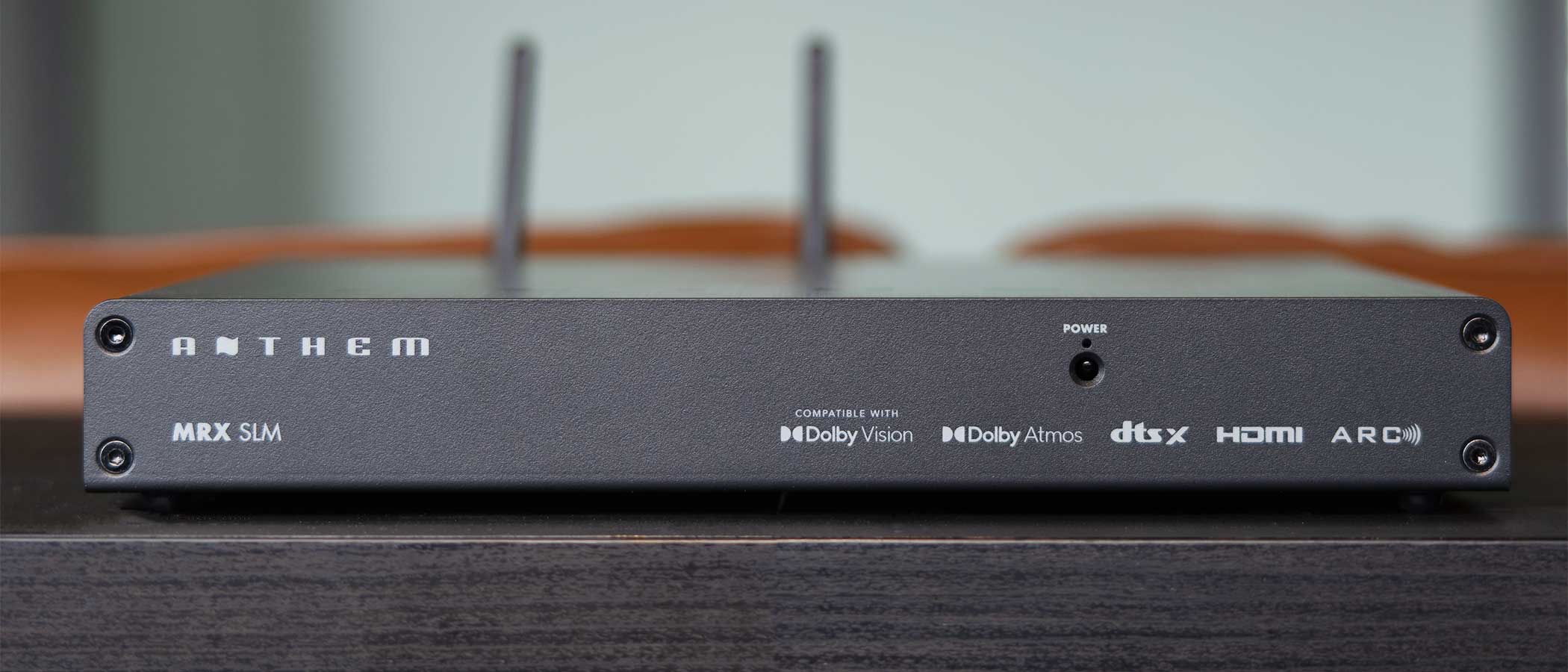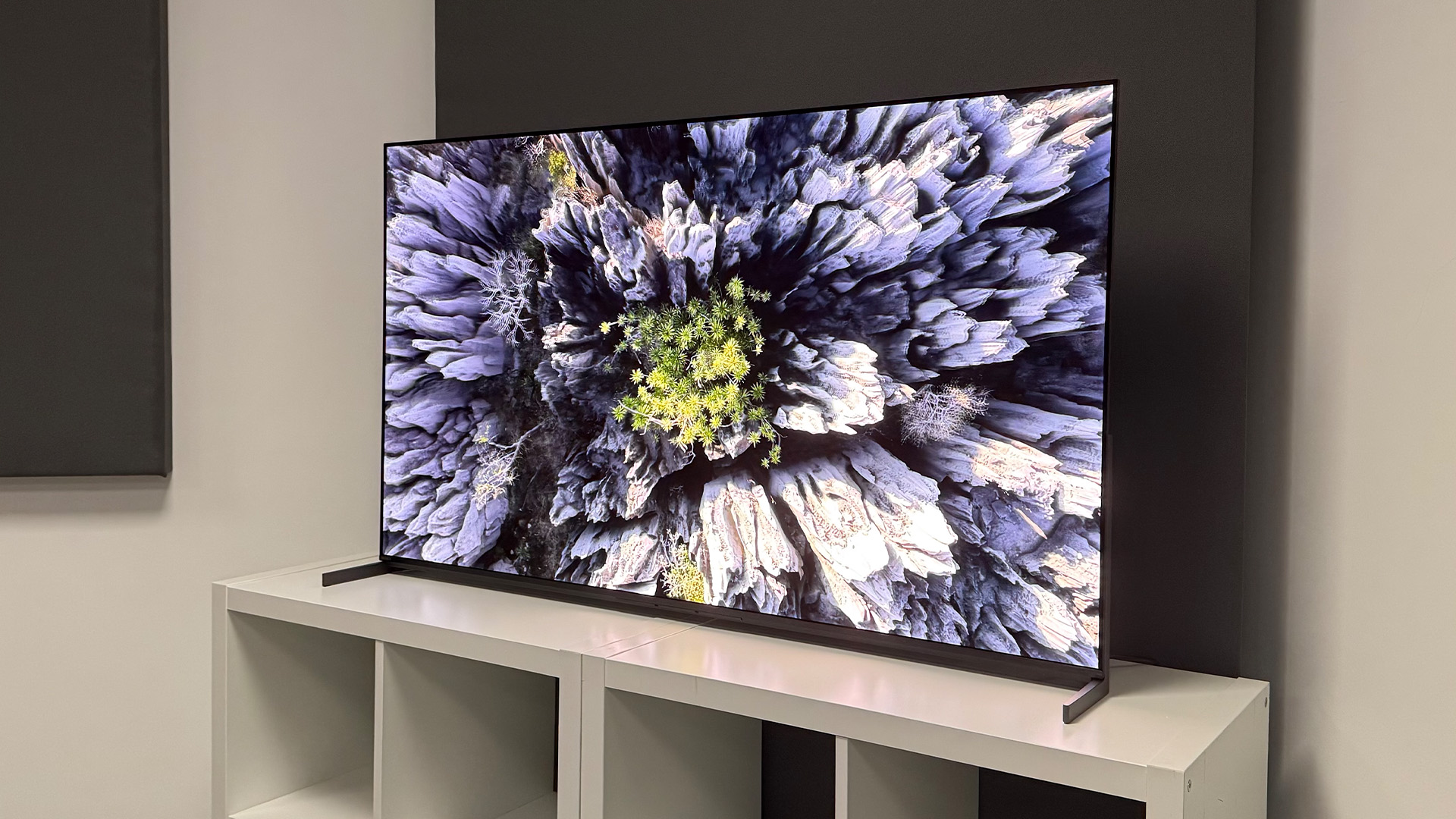Sound+Image Verdict
A potential game-changer: Anthem’s slimline receiver can power a five-channel surround sound system from a hideaway position, with high levels of performance and power for both movies and music. The reduced physical size brings a few specific limitations, but if those don’t affect your particular situation, then the MRX SLM could change your whole idea of how an entertainment system is put together.
Pros
- +
Amazingly compact
- +
Five channels of power
- +
Streaming & app control
Cons
- -
Limited inputs
- -
No expansion possible
Why you can trust What Hi-Fi?
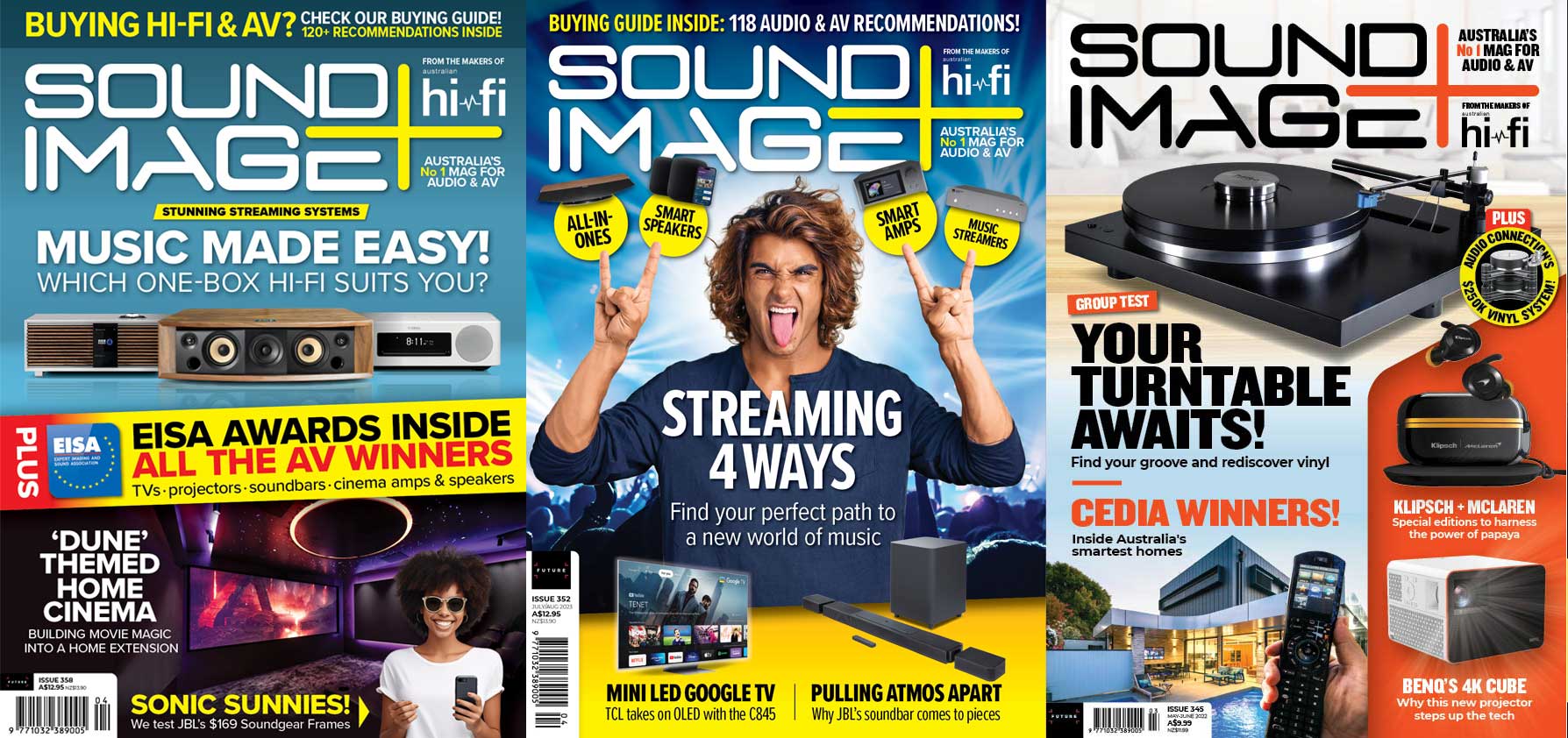
This review originally appeared in Sound+Image magazine, Australian sister publication to What Hi-Fi?. Click here for more information on Sound+Image, including digital editions and details on how you can subscribe.
As soon as we heard about the five-channel MRX SLM receiver, we asked to borrow one. Our motives were two-fold. Firstly we loved the concept: a full AV receiver packed into a chassis far lower than the usual double-height beasts which dominate home cinema racks, lower even than the ‘slimline’ receivers on offer from some companies. And secondly the MRX SLM comes from Anthem in Canada, one of our favourite amplifier and receiver brands (and one of the best-selling in the States and Canada), which since 2019 has been back in the hands of founder Scott Bagby and son John Bagby.
In fact we had asked three times before the Australian distributor Audio Active finally sent one over, a delay perhaps due to robust early demand. Once installed, it didn’t disappoint. On the other hand, the shrink-to-fit approach does provide some limitations; the MRX SLM won’t suit everyone. But it will surely delight those into whose systems it does fit.
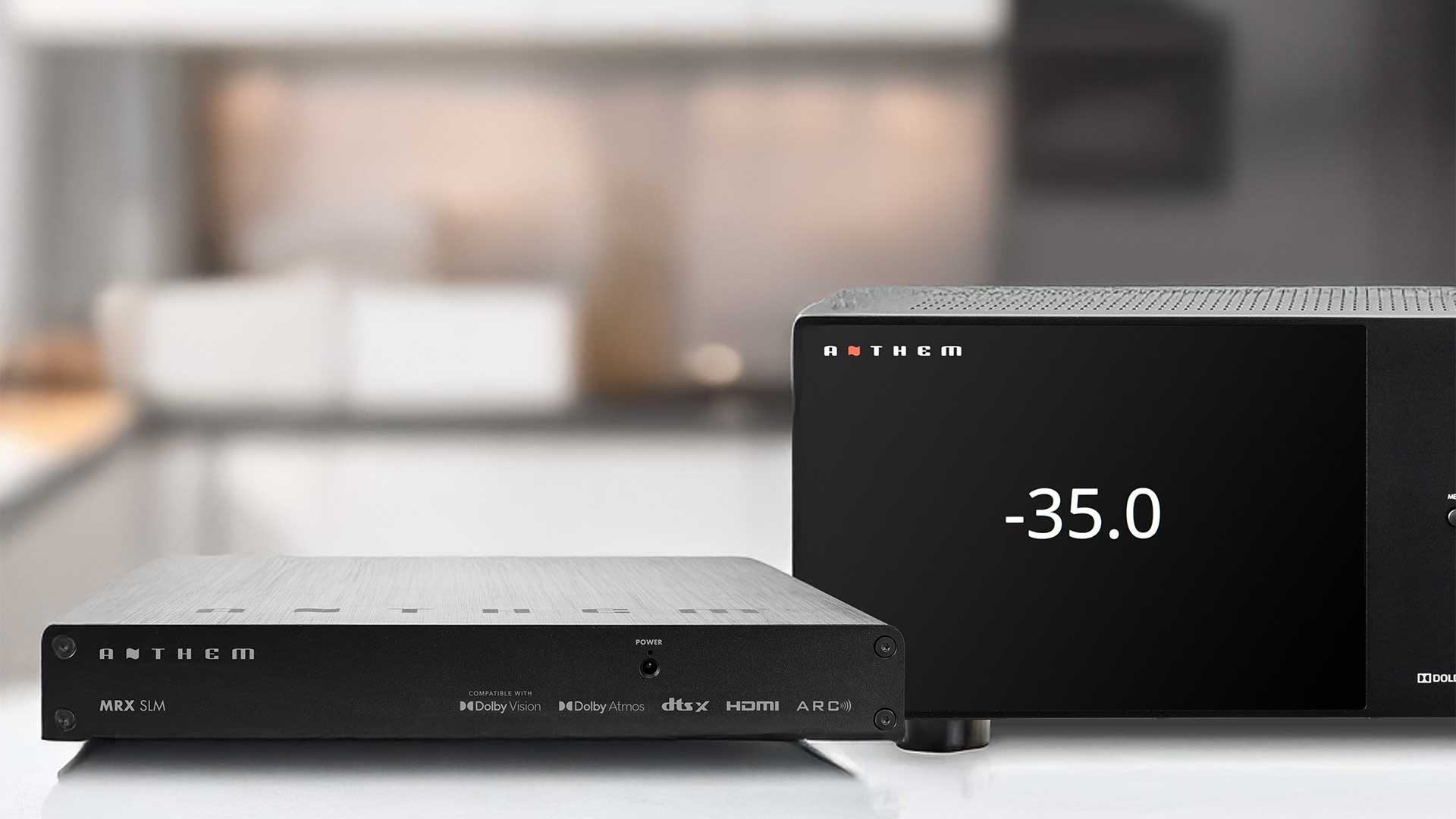
Build & features
The most obvious gift of the MRX SLM is its compactness. Where Anthem’s more traditional AV receivers can rise to heights of 16cm, the MRX SLM is 3.8cm high – that’s the height of, say, an AppleTV 4K media box: tiny. Width and length are 28cm, so it’s square from above, while less than 4cm high.
You can simply shelve it, using its stick-on rubber feet, or you could rack it. At 11 inches wide it’s far short of full rack-width, but there’s a 19-inch rack adaptor into which it fits neatly. Anthem has pics (see below) of multiple racked’n’stacked MRX SLMs.
It also comes with a mounting kit to put it vertically at the back of your TV, or on the wall, or between studs of the wall using a back box with full cable management, so it can be “out of sight, but not out of sound”, as Anthem neatly puts it.
It’s certainly worth considering your cable management options. AV receivers, of course, generally have an abundance of cable connections. Even with the reduced socket count of the SLM, hanging this amplifier vertically might, depending on your system, leave quite the collection of sidefacing or downhanging cables to accommodate, including five sets of speaker cables which are then required to spread somehow all over the room.
So if it’s neatness which attracts you to the MRX SLM, get your cable planning sorted well in advance of plugging it up. For our purposes we certainly found it easiest to keep the unit flat and horizontal.
The latest hi-fi, home cinema and tech news, reviews, buying advice and deals, direct to your inbox.
Having said that, the MRX SLM’s socketry is certainly simplified over the profusion of inputs and outputs which appear on the back of one of Anthem’s full-sized receivers.
Here you get just two HDMI sockets: one input for a source, the other with HDMI eARC which both forwards any HDMI input on to your TV and also plays any sound from the TV if you’re using its tuner, streaming, or other sources plugged into the TV. The eARC channel should allow full Atmos playback from TVs which can provide it.
There is just one optical audio input and a single analogue input, with that disappointingly on a minijack socket – that’s how tight the space gets on the rear panel, with barely room to fit in the Ethernet input, dual antenna sockets for Bluetooth/Wi-FI, an essential IR extender input for those hiding the SLM away – and that’s about it, except for a subwoofer out and the speaker connections.
Oh, the speaker connections. One price to pay for the size here is the loss of proper speaker binding posts, and the substitution of a Euroblock-style Phoenix connector for all 10 speaker cables. Having recently struggled with the fiddliness of a mere stereo Phoenix connector, this five-channel expansion did rather fill us with dread; it also precluded the use of our usual thick front speaker cable with banana plugs. The Phoenix connector block here is capable of handling cable only up to about 1.5mm thick; you need each cable perfectly trimmed down to leave 5mm of bare wire. Phoenix connector blocks are usefully removable, so you can screw down 10 cables into the marked holes, taking great care with polarity, then slide the block into place carefully. We had a small short first time, from rogue cable strands splayed on entry, but with careful prep the connections weren’t quite the nightmare we had anticipated.
The five channels are another limitation of the MRX SLM. For most users this will be best configured as three channels at the front (LCR) and two at the rear, with an active subwoofer connected to the subwoofer output, delivering 5.1-channel surround. That leaves no height available for Atmos content there, and no pre-outs available for expansion.
But there is another option, which is to run in 3.1.2 – so having height, but no rears. While this is an unusual and certainly less immersive option, it might be worth considering if you’re in a scenario where there’s no way to run rear cables.
Otherwise there seems no way here to, say, reallocate spare channels to biamp the front L/R channels, or to play to a second zone, which are common options on receivers. Of course with only five amplifiers and no pre-outs, that would leave you listening in 3.1.
It is easy to make and implement any such configuration changes because despite its low-slung convenience, the MRX SLM comes equipped with pretty much the full control implementation of all Anthem receivers, including the Anthem Remote app for iOS and Android, and our favourite interface of all: Anthem’s marvellous web user interface. Once it’s networked, just type its IP address into any browser on your network, and you have full control over everything from general operation to level tweaks to full-on calibration.
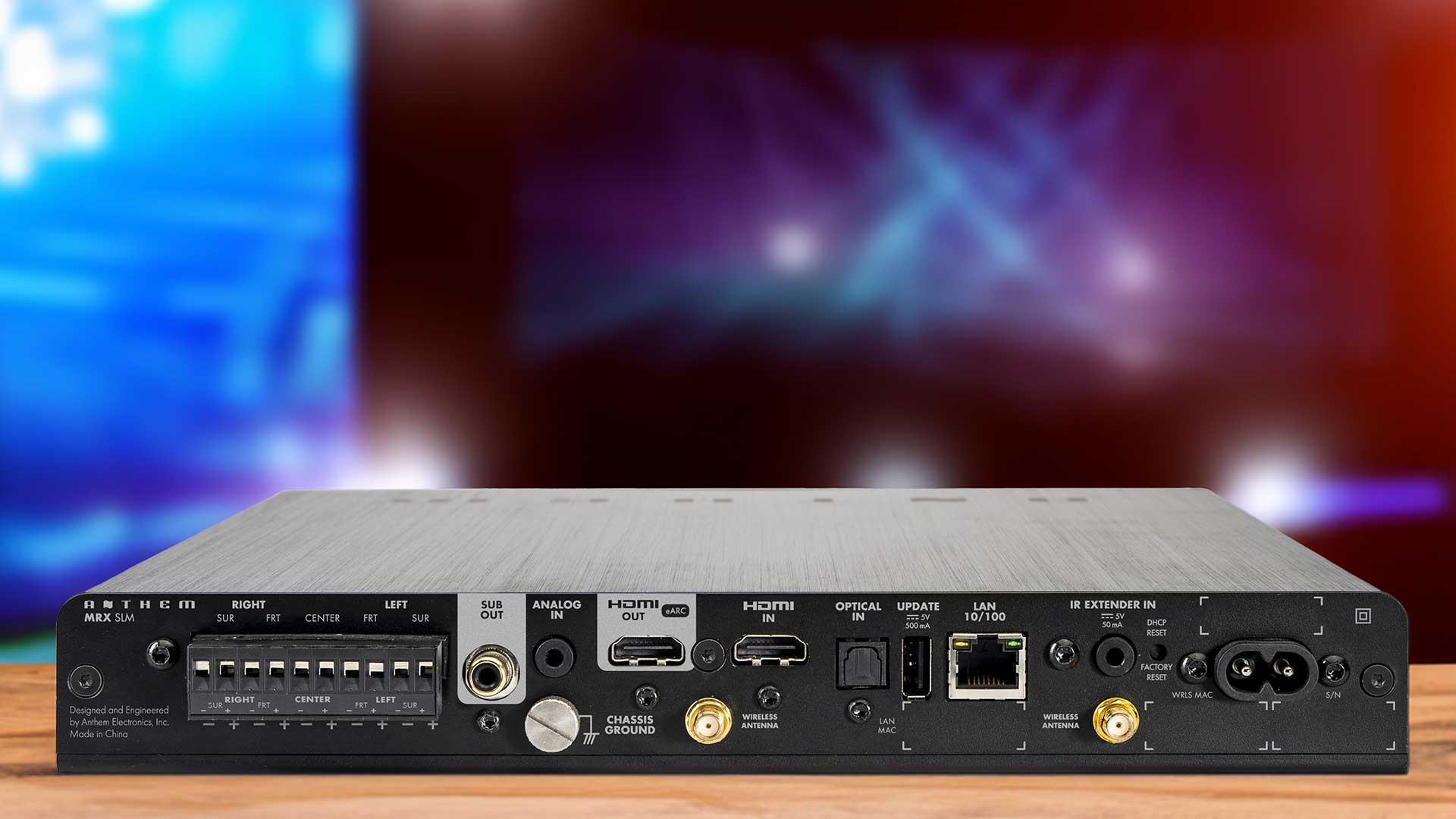
Inputs & profiles
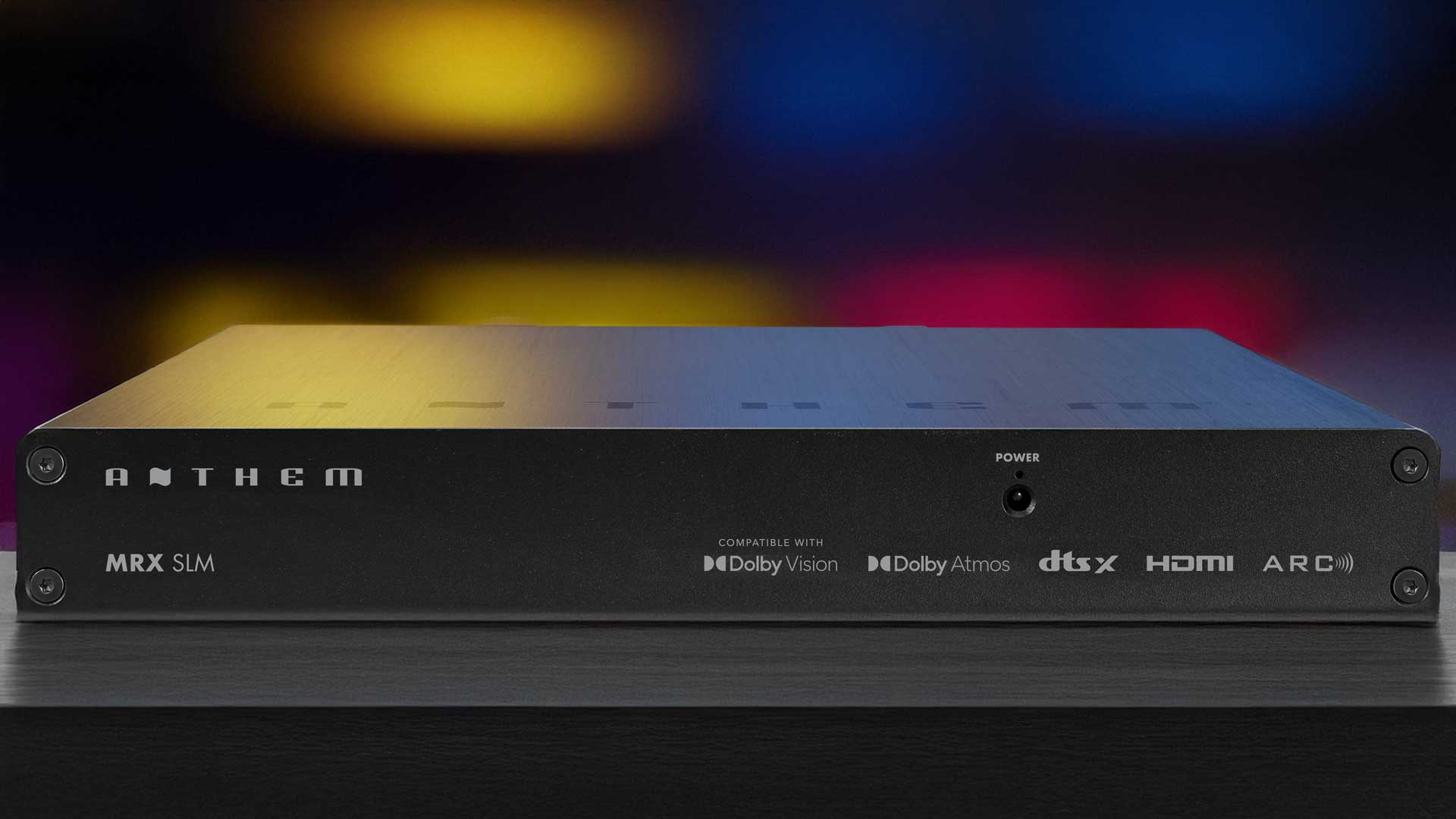
Inputs: HDMI, HDMI eARC, minijack analogue stereo, optical digital, Ethernet, Wi-Fi, IR extender, USB-A (updates), Spotify Connect, Apple AirPlay, Google Cast, Bluetooth (codecs not stated)
Outputs: HDMI, subwoofer out, speakers out (10-slot Phoenix connector)
Output power: 5 x 50W into 8 ohms (two channels driven, 20-22kHz, 0.1% THD)
Dimensions (whd): 27.9 x 3.6 x 27.9cm
Weight: 3.0kg
Having lived with most brands of AV receiver and become accustomed to their ways, we have little hesitation in proclaiming Anthem’s method of inputs and profiles to be among the simplest and most versatile in set-up, and particularly in allowing easy switching between different scenarios designed for different purposes and different inputs.
For example, we will listen to movies in full surround, so here that might be an Atmos soundtrack rendered to 5.1. But if we are listening to Atmos music, rather than movies, we prefer to have a virtual centre, and so choose to listen in 4.1.2 if the channels are available, or here without our height channels in either 4.0 without subwoofer, or 4.1 for the extra welly deep down below (our usual choice).
On some receivers that would be a complicated bit of preset creation, potentially needing a tweak every time you wanted to move between modes. But Anthem allows you not only to set up different speaker profiles for such scenarios, but also to create virtual inputs for each individual situation.
So the HDMI input for our AppleTV 4K might be called just ‘AppleTV’ for movie and TV watching, using Profile 1 to listen in 5.1.
But we could make another input called ‘AppleTV music’, also using the same HDMI eARC as input, but auto-selecting Profile 2, which is configured for 4.1. Admittedly this input won’t be on the physical remote control, which offers the default inputs. But the virtual inputs will be on the app and the browser interface, making selection pretty easy.
We also love the ease with which you can sit in your seat and use the app to calibrate each channel by entering distances then listening for level with test tones. There is also Anthem’s ARC (Anthem Room Correction), and again we have tried many room correction systems to conclude that Anthem is one of the few which we sometimes (not always!) leave in circuit for actually improving the sound. Anthem ARC was created out of the famous Athena research at Canada’s National Research Centre dating back to 1988, co-funded by Canadian companies including Axiom, Paradigm and PSB Speakers.
“The goal of the Athena project was to design a ‘smart loudspeaker’, a speaker that could self-calibrate the frequency response in a room to fit a target curve determined by subjective double-blind screen listening tests, using DSP to do the room correction,” Paul Barton of PSB Speakers told us recently, and Athena’s room-correction research was later used, inter alia, to create the ARC correction in Anthem receivers, here in the latest Genesis version.
Even with this smaller receiver you get a calibrated USB microphone in the box to connect to your computer (the software runs on your computer, not the receiver), though not the full-sized mike stand that comes with Anthem’s larger models. You measure from at least five positions, these being where your head would normally be, then the front left and right or your couch, and a little behind the left and right of your couch. You can then store the results, turn the correction on or off, and choose to use it in your input definitions or not, as you prefer for different sources.
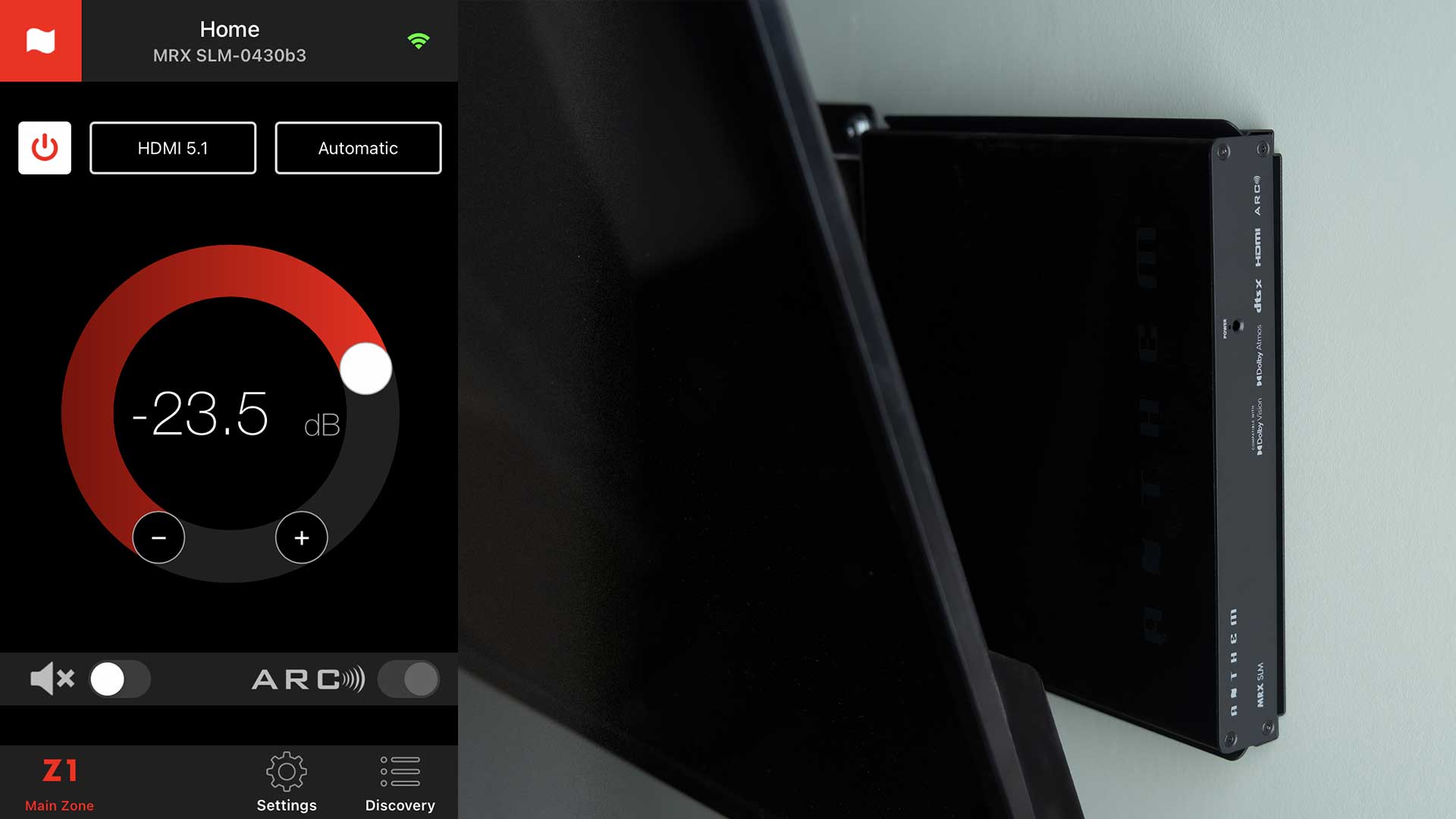
Control & streaming
We’ve already seen how useful the browser-based control interface can be; your other choice is the Anthem Control app (above). This not only speedily spots your networked device and connects quickly when required, its main screen has a big circular volume slider, its very size allowing finer and more precise control than buttons or horizontal sliders, although occasionally we did slip and engage rather high levels accidentally. (You can set a maximum volume if this happens too often!)
Marvellous further flexibility comes from a touch of the ‘Settings’ button in the app, bringing up individual sliders for bass, treble, and for each individual set of speakers, so there’s front L+R on one slider, centre on another, subwoofer, and rears (or height) together. This doesn’t mess with your overall calibrated settings within the Speaker Profiles, and adjustments are easily returned to their default positions, so this is great for perhaps hottening your rears temporarily for a soundtrack which benefits from this slight departure from reference, or to shove up the centre channel if dialogue is getting lost, and particularly, we found, to tweak the balance for surround and Atmos music, of which we are great fans.
You can also make more permanent adjustments by entering the Setup Menu and creating up to four speaker profiles, additional duplicate inputs with different treatments, as well as storing and loading user settings.
Besides surround material, there is also stereo music, of course, to which you can listen in straight L and R stereo, or you might set up a Profile and Input to play stereo in 2.1 with the subwoofer, or 3.0 or 3.1, or even ‘all-channel stereo’, which may not be strictly ‘hi-fi’ but which does make use of all your available amplification and can be just the thing when entertaining.
Your music can come from apps on your TV, from a plugged-in media player, or from the Anthem’s own streaming abilities. There is Google Cast streaming (good from Android devices) and Apple AirPlay (good but often limited in quality by Apple from iOS devices), while Spotify Connect lets you use the Spotify app on your phone to control a stream direct to the receiver. There’s no Tidal Connect, though, and the Bluetooth is limited to the SBC codec and perhaps AAC, with no higher third-party codecs available.
There’s one more control option: via the network from third-party integration solutions, including Savant, Crestron, Control4, URC, RTI and ELAN. In which case you’re likely leaving all the hard work to a professional installer, and can simply settle back to enjoy the results. As we now did.
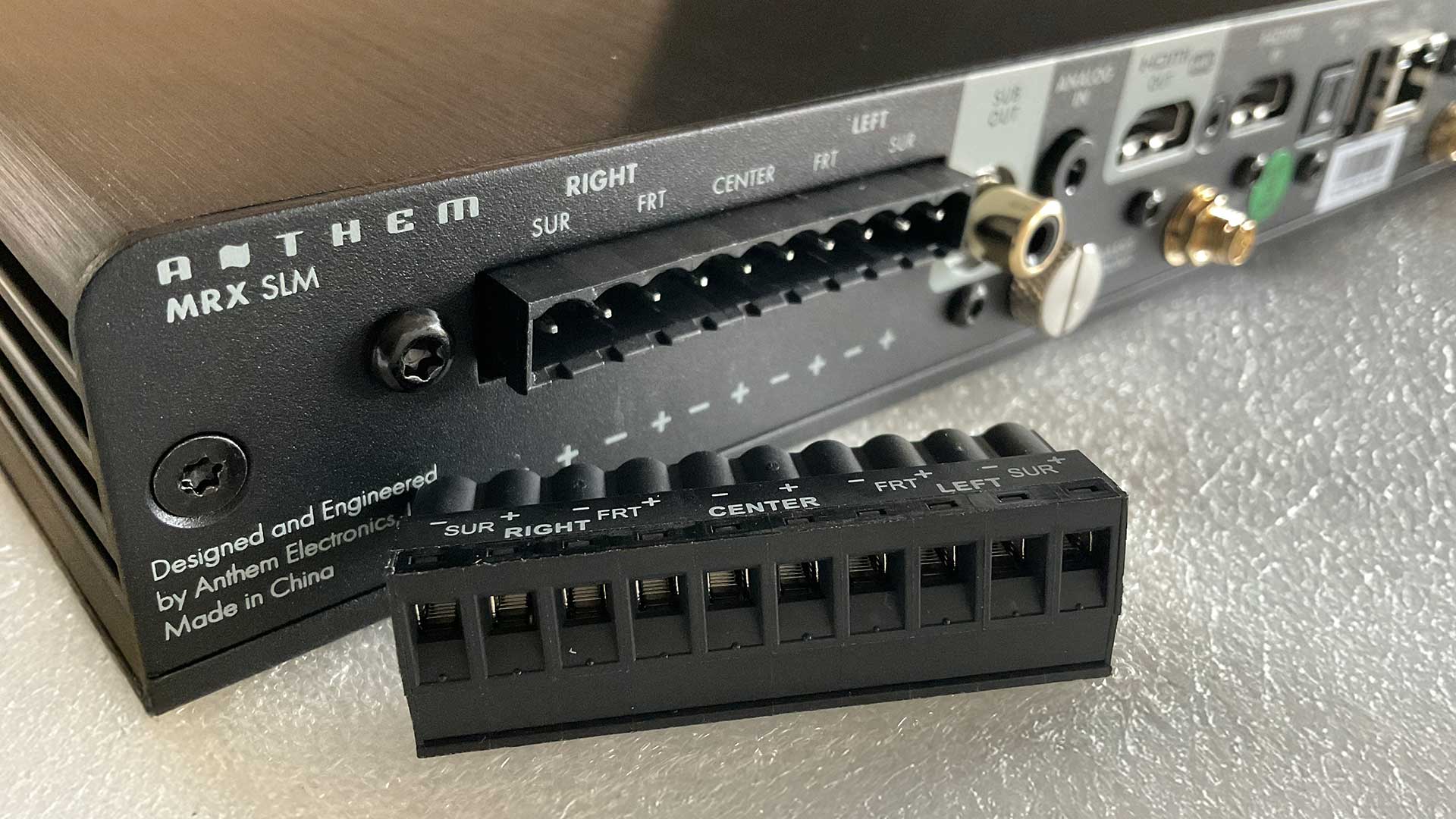
Listening sessions
We began in stereo, and we figured that if the MRX SLM was going to reveal its limitations, it would be when running only two channels for critical stereo listening. But no apparent limitations were revealed. Perhaps the best compliment we can give this receiver was that it stayed in our music room for three weeks without us ever hankering to get our reference power amps back behind the music; we even had a music night with guests, and not only forgot to mention that it wasn’t our usual amps, we didn’t even remember that ourselves until after they had gone. The music flowed forth beautifully at whatever level we demanded.
But why listen to boring old two-channel when you can listen in five-channel? Got any old music DVDs? Check the soundtracks: some have not only 5.1 but high-res DTS 5.1, which is about as good as you can get – discs as common as Best of Bowie or Ladies & Gentleman George Michael have fantastic 5.1 mixes on the DVDs. Or treat yourself to a copy of the Beatles ‘Love’ CD+DVD 2-pack (commonly around on eBay); select the high-res DTS soundtrack and crank it.
That was our first post-warm-up surround treat; we never listen to anything less than the whole disc of ‘Love’, and by the time we’d reached Eleanor Rigby we’d established beyond doubt that both quality and power more than acquit themselves under the trial of surround music. The guitar in Julia panned lazily across the front soundstage while the rears whirled ambulance effects and atmosphere hinting at this tragedy in Lennon’s life, then in bursts the thrilling rip-it-up remix of I Am The Walrus, a full system work-out, and still no apparent limitations imposed by the size constraints of the MRX SLM.
So what are the amplifiers in here? Anthem’s bigger receivers use proper Class-AB power, but could they fit it five Class-AB amps in a box this size? We had guessed they had done so, given that after a good session the SLM could run quite hot, so that if you do hide it or rack it, we’d suggest giving it some surrounding air space, although Anthem’s racking image above shows several of them stacked pretty tight.
But no, these are Class-D amps (no word on whose), confirms Australian distributor Audio Active; they are rated at 50W each into 8 ohms. This made us even more impressed by the MRX SLM’s musical abilities.
Especially when from Blu-ray via HDMI we played the recent Atmos release of
‘Ziggy Stardust & The Spiders From Mars’, a magnificent remix by original engineer Ken Scott, and an exemplar of how a classic album can get an Atmos treatment. It truly surrounds you, and without the ‘effects’ of ‘Love’, just brilliantly mixed. If you’ve never liked surround music, try this one.
We also played a good bit of Atmos from Tidal (through an AppleTV 4K connected to the HDMI input); we only slightly missed the additional immersion of our usual height speakers; Atmos height is often mighty subtle.
We had already been running casual surround TV and movies, but we loaded up the Blu-ray of Oppenheimer. When played at the Cremorne Orpheum in Sydney this had been one of the loudest movie presentations we’d ever seen… and the home version doesn’t disappoint. In the opening scene Oppenheimer stares into a puddle; we set our levels on this pitter-patter of rain and the accompanying music, then seconds later a fireball bursts into the sky with an effect not only massive, tinglingly visceral indeed, but also sharply-etched and edged, with every sound in the following crescendo impeccably controlled, every angle of delivery accurate.


Ours is not a huge listening room, so perhaps a larger room would reach the power limits of the little MRX SLM, but our experience was unrestrained, full-on dramatic. Indeed such was the workout given to the Anthem plus Krix subwoofer during this brief scene that the missus came rushing from downstairs, informing us that Mr Oppenheimer was disturbing wildlife resting in the bathroom below. An impressive first for our system.
Jarhead, played from a mere 5.1-channel DVD, was another soundtrack to demonstrate the placement and impact of effects: the Gulf War battle sequences, one-sided as they were, hurled explosions all around the soundstage, with whip-crack transients and apparently no shortage in the reserves. It’s hard to imagine an Atmos delivery of this soundtrack being any more immersive even with added height.
From Netflix, playing via the HDMI eARC from the TV, we enjoyed a delightful combination of dramatic, atmospheric and musical surround in the cyber-thriller Leave The World Behind, the rears pumped up even through the Joey Bada$$ intro theme and nicly for the house-gazing sequence with a hip-hop soul soundtrack by Blackstreet.
Again the ability to tweak surround and subwoofer levels in the app made it so easy to achieve exactly the right balance. And more: with every movie we played, we were reminded how much more entertaining movies are when delivered with powerful sound, and surround. The ease of tucking this receiver away, even racking it elsewhere, could help bring surround sound back to rooms where it has been neglected since modern décor banned cables and boxes at the back of the room. With a bit of planning, the MRX SLM could operate with remarkable discretion, but to great effect.
If you do hide it, you should run an IR receiver on a cable to somewhere convenient, so that you can keep using the physical remote control, even though the phone app will still work over the network.
The smart app also helped overcome the only operational issue we encountered, which was when selecting an input with the remote control. We would select ‘analogue’ (our computer audio via DAC was connected this way), then start music playing, but we would invariably still need to select ‘analogue’ again before hearing the input. If we paused listening for a while we might need to select it again. The same happened when selecting the external HDMI input.
We think this may have been the MRX SRM switching automatically back to HDMI ARC, because the TV was active. We tried turning off HDMI CEC to prevent this, at the cost of losing additional volume control from the TV remote, but it persisted. So we just got used to doing it twice. One thing that might help enormously would be having a multicolour LED on the front panel to indicate the current input status.
The other things to consider carefully are the few specific limitations of the compact design: only five channels, limited physical inputs, the Phoenix speaker connections, and no pre-outs for left and right, which we normally use to feed superior power amps for stereo music listening. That last is a pity, as if Anthem did so, you might be able to reallocate the MRX SLM’s amps for everything else in a 5.1.2-channel system, thereby restoring height along with surround. Currently it’s a choice of either/or, when both would be more fun.

Verdict
But what a game changer. Anthem’s slimline receiver can fully power a five-channel surround sound system from a hideaway position, with high levels of performance and power for both movies and music.
The reduced physical size brings a few specific limitations, but if those don’t affect your particular situation, then the MRX SLM could change your whole idea of how an entertainment system is put together.
Equally importantly it shows how clever thinking can create a different and potentially better way of doing things.

Jez is the Editor of Sound+Image magazine, having inhabited that role since 2006, more or less a lustrum after departing his UK homeland to adopt an additional nationality under the more favourable climes and skies of Australia. Prior to his desertion he was Editor of the UK's Stuff magazine, and before that Editor of What Hi-Fi? magazine, and before that of the erstwhile Audiophile magazine and of Electronics Today International. He makes music as well as enjoying it, is alarmingly wedded to the notion that Led Zeppelin remains the highest point of rock'n'roll yet attained, though remains willing to assess modern pretenders. He lives in a modest shack on Sydney's Northern Beaches with his Canadian wife Deanna, a rescue greyhound called Jewels, and an assortment of changing wildlife under care. If you're seeking his articles by clicking this profile, you'll see far more of them by switching to the Australian version of WHF.
